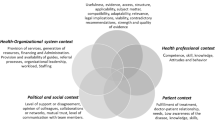Abstract
Clinical practice guidelines have gradually become a normal part of daily life for many clinicians. In order to provide good support for practitioners and patients in their decisions on appropriate care, the practice guidelines should be of high quality, i. e. developed by a credible organisation, based on the best available scientific evidence, tested for applicability, implemented through multiple strategies, and their use and impact continuously monitored.
Many of the guideline development programmes in Europe do not meet these criteria. Guideline-setting initiatives in seven European countries are presented in this review. Of these, three specific programmes are described in detail: one that is mainly professionally driven (The Netherlands), one that is primarily academically driven (UK), and one that is mainly based on initiatives by the authorities (France).
Large intercountry differences are evident in guideline setting initiatives. These differences include the nature of the guidelines, their aims, the methods used, the measures to promote implementation, and the people involved. Cost considerations have to date rarely been included.
Well designed programmes for implementing the guidelines are usually lacking: implementation is often restricted to mailing the guidelines or presenting them in journals.
As yet, there is a scarcity of any monitoring of the acceptance, use and impact of these guidelines.
Despite these limitations, positive trends can be seen in guideline development in Europe. These include: a shift towards guidelines based on the best evidence available, and developed through formal, systematic and explicit procedures; more attention to effective implementation of practice guidelines; and, more attention to the role of the patient in guideline development, as well as in shared decision-making based on guidelines.
Such trends mark the direction in which the development of clinical guidelines in Europe will probably progress. However, in a few year’ time, there will be the danger of an overload of guidelines, which may be conflicting in their advice to doctors thus creating confusion and resistance. Specific criteria for high quality clinical practice guidelines and continuous improvement in the procedures for developing and implementing guidelines will be an important next step.
Similar content being viewed by others
References
Field S, Lohr K. Clinical practice guidelines. Washington, DC: National Institute of Health, 1992
Woolf S, Grol R, Hutchinson A, et al. Clinical practice guidelines I: the potential benefits, limitations, and harms of recommending how to care for patients. BMJ. In press
Cluzeau F, Littlejohns P, Grimshaw J, et al. Appraising clinical guidelines and the development of criteria: a pilot study. J Interprof Care 1995; 9: 227–35
Selbmann HK, editor. Guidelines in health care. Report of a WHO conference. Baden-Baden: Nomos Verlag, 1998
Woolf S, Grol R, Hutchinson A, et al. Clinical practice guidelines 2: an international overview. BMJ. In press
Varonen H, Mäkelä M. Practice guidelines in Finland: availability and quality. Q Health Care 1997; 6: 75–9
Mäkelä M. Do general practitioners need guidelines? Scand J Prim Health Care 1996; 14: 2–3
Durieux P, Ravaud P. From clinical guidelines to quality assurance: the experience of Assistance Publique Hopitaux de Paris. Int J Q Health Care 1997; 9: 215–9
Maisonneuve H, Colin C, Matillon Y. French regulatory medical references are criteria, not clinical guidelines [letter]. BMJ 1996; 313: 818
Maisonneuve H, Cordier H, Durocher A, et al. The French clinical guidelines and medical references programme: development of 48 guidelines for private practice over a period of 18 months. J Eval Clin Pract 1997; 3: 3–13
Reinauer H. Clinical practice guidelines for diagnosis and therapy in Germany. In: Selbmann HK, editor. Guidelines in health care. Baden-Baden: Nomos Verlag, 1998
Thomas S. Standard setting in the Netherlands: impact of the human factor on guideline development. Br J Gen Pract 1994; 24: 242–3
Grol R, Thomas S, Roberts R. Development and implementation of guidelines for family practice: lessons from the Netherlands. J Fam Pract 1995; 40: 435–9
Eccles M, Clapp Z, Grimshaw J, et al. North of England evidence based guidelines development project: methods of guideline development. BMJ 1996; 312: 760–2
Sheldon T, Melville A. Providing intelligence for rational decision-making in the NHS: the NHS Centre for Reviews and Dissemination. J Clin Eff 1996; 1: 1–4
Chalmers I, Haynes B. Reporting, updating and correcting systematic reviews of the effects of health care. BMJ 1994; 309: 862–5
Mann T. Clinical guidelines: using clinical guidelines to improve patient care within the NHS. Leeds: NHS Executive, 1996
Grol R, Baker R, Roberts R, et al. Systems for quality improvement in general practice: a survey of 26 countries. Eur J Gen Pract 1997; 3: 65–8
Grol R, Lawrence M. Quality improvement by peer review. Oxford: Oxford University Press, 1995
Hulscher M, Van Drenth B, Van der Wouden J, et al. Changing preventive care: a controlled trial on the effects of outreach visits to organise prevention of cardiovascular disease. Q Health Care 1997; 6: 19–24
Van Drenth B, Hulscher M, Mokkink H, et al. Effects of outreach visits by trained nurses on cardiovascular risk-factor recording in general practice: a controlled trial. Eur J Gen Pract 1997; 3: 90–5
Durand-Zaleski I, Colin C, Blum-Boisgard C. An attempt to save money by using mandatory practice guidelines in France. BMJ 1997; 315: 943–6
Woolf S. Shared decision-making: the case for letting patients decide which choice is best. J Fam Pract 1997; 45: 205–8
Thomson R, McElroy H, Sudlow M. Guidelines on anticoagulant treatment in atrial fibrillation in Great Britain: variation in content and implications for treatment. BMJ 1998; 316: 509–13
Fahey TP, Peters TJ. What constitutes controlled hypertension?: patient based comparison of hypertension guidelines. BMJ 1996; 313: 93–6
Author information
Authors and Affiliations
Corresponding author
Additional information
About the Author: Professor Richard Grol is Director of the Centre for Quality of Care Research, a research collaboration between the Universities of Nijmegen and Maastricht, The Netherlands. His research interests include guideline setting and implementation, quality management, patient involvement in healthcare and quality of care for patients with a chronic disease. He is also Chairman of the European Working Party on Quality in Family Practice (EQUIP), a collaboration of 25 European countries.
Rights and permissions
About this article
Cite this article
Grol, R., Eccles, M., Maisonneuve, H. et al. Developing Clinical Practice Guidelines. Dis-Manage-Health-Outcomes 4, 255–266 (1998). https://doi.org/10.2165/00115677-199804050-00002
Published:
Issue Date:
DOI: https://doi.org/10.2165/00115677-199804050-00002




